From mating to nesting to simply survival, camouflage is one of the greatest assets that birds can use. There are so many uses for camouflage that, unsurprisingly, many different bird species have evolved the ability. In this article, we’ll be taking a look at 18 different bird species that have evolved the capability to camouflage, as well as the mechanisms behind each species.
1. Green Broadbill
Scientific Name : Calyptomena viridis
Range : Sumatra, Borneo, Malaysia
The green broadbill is a bright green bird with an umbrella-like head shape and leaf-like body shape that is often found in lowland forests.
They display clear sexual dimorphism, with the male having black wing bars and a black spot in the shape of a comma behind its eye and the female having no black markings and being paler in overall color. They differ from other broadbills, such as the Hose and Whitehead, in that they are often found at lower elevations.
Because of its color and body shape, as well as the fact that it tends to stay motionless throughout the day, the green broadbill can blend into its surroundings in the forest very easily. They’re nearly impossible to be seen from above, thus significantly reducing their chances of becoming prey.
2. Eastern Screech Owl

Scientific Name: Megascops asio
Range: United States (east of the Rockies)
The eastern screech owl is a pint glass-sized owl of gray or reddish-brown plumage. They can be found wherever trees are present, whether in the woods, suburbs, or parks.
The male is typically the smaller of the genders, along with having a deeper voice. Because of their smaller size, the males are more agile than females; therefore, the males do all of the hunting for the females and their chicks.
Probably the biggest reason you can find them wherever trees are present is that their plumage blends so well with the tree bark. They blend in so well that the owls usually just rest in the tree cavity during the day without the slightest worry of being preyed upon.
3. Himalayan Snowcock
Scientific Name: Tetraogallus himalayensis
Range: Himalayas (and adjacent mountain ranges), United States (Ruby Mountains, Nevada)
The Himalayan snowcock is a relatively large game bird (about 2 feet tall, weighing up to 6 pounds) with a gray body, white neck with two brown streaks running down, and orange-brown markings on top of its head and body.
They were introduced to the Ruby Mountains in Nevada in 1963. There, they live on steep and barren slopes above the tree lines, which makes spotting and visiting them especially difficult.
Because of where they live, the Himalayan snowcocks are under the constant threat of predation from eagles and other predators. Thankfully, the colors and pattern of their plumage appear very similar from above to the appearance of the snowy cliffs that they reside on, making them masters of camouflage.
4. Egyptian Nightjar
Scientific Name: Caprimulgus aegyptius
Range: Europe, North Africa, and Southwest Asia
The Egyptian nightjar is a relatively large (averages roughly 10 inches in length), dull-colored nightjar with long wings (averages roughly 22-25 inches). Like other nightjars, this species has a wide mouth and soft plumage. They are most often found in flat, open, sandy deserts with few trees/shrubs, though they may also be seen in grassland or shrubland.
Because their plumage is covered in varying brown streaks and bars, they can blend in easily into their surrounding sandy environment.
And considering that their underside is also of a similar color, it’s nearly impossible to pinpoint them in their surroundings no matter which position they lie in. This incredibly intricate camouflage is what enables these overall small-sized birds to rest on the ground even during the light of day.
5. American Bittern
Scientific Name: Botaurus lentiginosus
Range: Central America, United States, Canada
The American bittern is a relatively widespread but elusive species of heron. They are covered in brown, streaky stripes that can make them particularly difficult to identify. They are often found in tall marsh vegetation, where they’ll await the arrival of fish, amphibians, and insects to prey upon.
Unlike the other examples we’ve looked at so far, the American bittern not only resembles its surroundings but also changes its behavior to make its camouflage even more impressive. Since they’re often found in marshes and wetlands, American bitterns often stretch their necks upward and sway with the wind to mimic the reeds and tall grasses around them.
Because of how well they’re able to camouflage within the dense marsh vegetation, one of the best ways to spot them is by listening to their “booming” calls, which the male uses to defend its territory.
6. Fox Sparrow
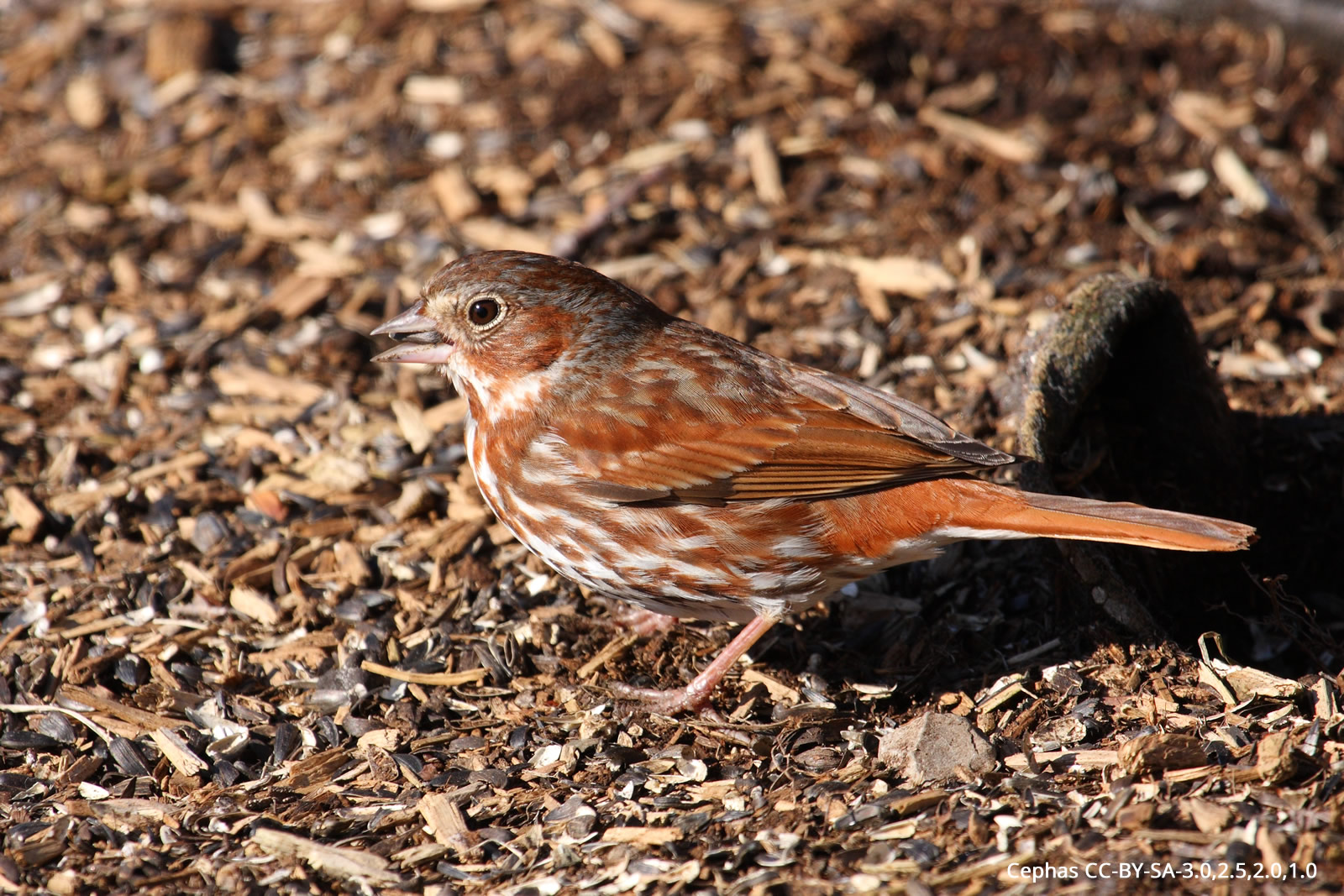
Scientific Name: Passerella iliaca
Range: United States, Canada
The fox sparrow is a large, somewhat stout sparrow (they’re one of the largest recorded sparrows) that inhabits the majority of the US and Canada.
They mainly inhabit the Eastern United States and along the South Pacific Coast during the winter before migrating west to Alaska, Canada, and the western mountains during the breeding season in the summer. A characteristic of this bird is that they are ground foragers, meaning you’ll often see them kicking around dense thickets on the ground in search of food.
Because of the colors of its plumage, which is generally rust brown with brown spots on the flanks and chest, the fox sparrow can camouflage into its surroundings, which are usually leaves or shrubs. And considering they spend the majority of time in these thickets searching for food, it’s the best way for them to avoid predators.
7. Eastern Towhee
Scientific Name: Pipilo erythrophthalmus
Range: United States (mainly east of the Mississippi)
The eastern towhee is a relatively large sparrow with black and rusty-brown plumage. They typically inhabit open woods, undergrowth, and brushy edges, though the exact type depends on their location within the eastern United States.
Though their camouflage makes them difficult to locate, they make loud calling noises and can rummage in the leaves quite loudly, thus revealing a general idea of their location to the careful observer.
Similar to the fox sparrow, the eastern towhee also depends heavily on its plumage to help immerse it into its surroundings. Since they both forage and nest on the ground, it’s crucial that they have a way to avoid predators in broad daylight. Luckily, their plumage helps them do just that.
8. Willow Ptarmigan
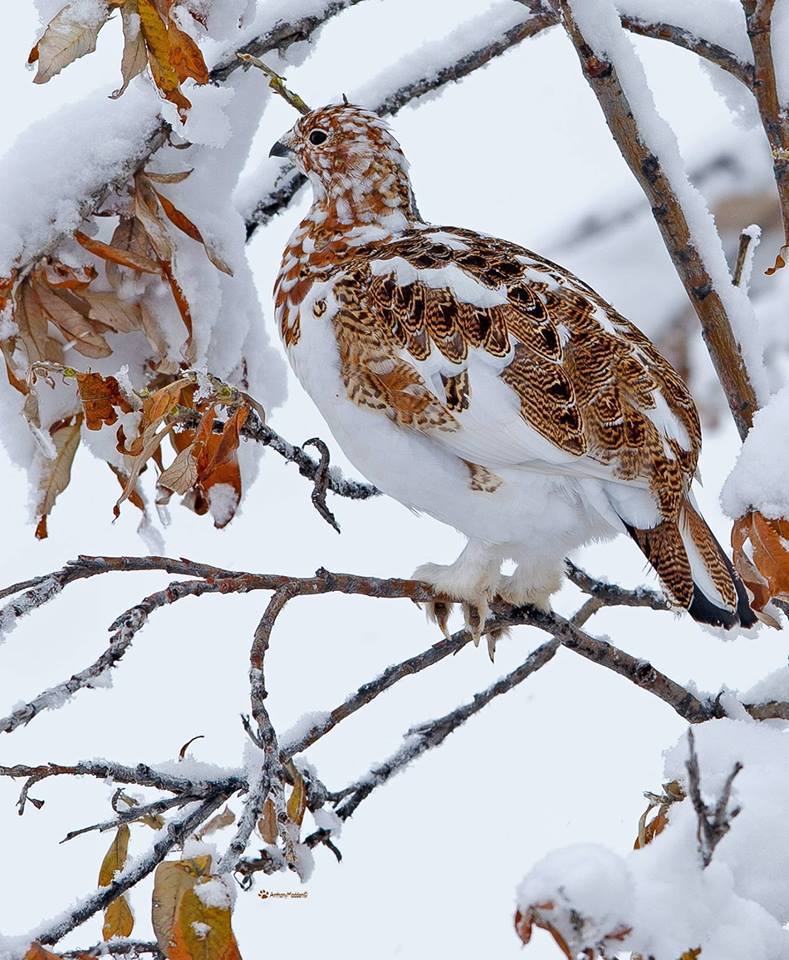
Scientific Name: Lagopus lagopus
Range: Northern Europe, Scandinavia, Siberia, Alaska, and Canada
The Willow Ptarmigan is a large grouse that has a plumage that can change appearance depending on the season. Because they’re heavily feathered and are capable of camouflage, the willows can live year-round in the cold subarctic tundra, occasionally perching on bushes or fences.
The willow’s diet depends heavily on the season; during the summer, when insects are more abundant, the willows will consume a mix of them and fruits/berries, while during the winter, they’ll consume a completely plant-based diet.
This bird, unlike those we’ve gone over previously, is unique in that it can change its appearance based on the season. During the summer, their plumage will take on a spotted brown, grey, and red look, while during the winter, their plumage will change to an all-white appearance to match the snowy backdrop.
This intricate method of camouflage makes these birds highly efficient in surviving in a constantly changing environment.
9. Piping Plover

Scientific Name: Charadrius melodus
Range: United States (along the Atlantic Coast, Great Plains, and Great Lakes)
The piping plover is a small plover with a short bill, a pale, sandy gray back, orange legs, and a black collar. They nest in soft, sandy beaches, tidal flats, and sandbars (depending on whether it’s near the ocean or river). Their diet consists of almost anything that they can find along the shores or sandbars, such as insects, marine worms, and crustaceans.
The piping plover can blend in very well into its sandy surroundings due to its sandy gray back. This, combined with their minuscule size and the fact that they like to hide in troughs, can make them very difficult to spot unless it’s on the move, during which time you’ll be able to catch a glimpse of their bright orange legs and black collars.
Despite their mastery of camouflage, they are currently considered endangered due to habitat loss and human disturbance. Therefore, it’s best not to disturb these little birds and stay a considerable distance away if you ever happen to spot one.
10. Great Potoo

Scientific Name: Nyctibius grandis
Range: Central America (from Southern Mexico to Bolivia)
The great potoo is a rather large nightbird, bigger than other potoo species, which looks similar to owls but is not related. They are pale gray and have a large head that lacks a mustache stripe.
These birds live primarily in forests and rainforests, though they’re occasionally spotted at farmlands and forest edges. As nocturnal birds, the great potoo hunts insects at night; thus, they’re usually found perched on branches high above the ground during the day.
The dull grey color of their plumage, along with their posture, allows the great potoos to camouflage perfectly into the branches during the day. They’re so well blended in that they are usually found motionless on the branches with their eyes closed for the entirety of the day.
11. Great Gray Owl
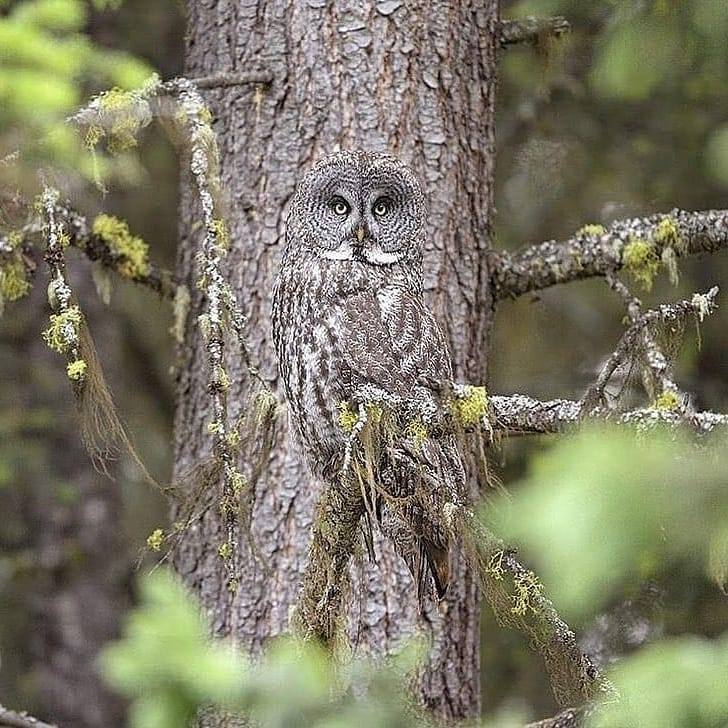
Scientific Name: Strix nebulosa
Range: Northwestern United States, Canada, and Alaska
The great gray owl is a large owl with yellow eyes and a white bow-tie-shaped pattern on its neck. Although these owls primarily reside in the boreal forests and cold mountain meadows of the western United States and Canada, they do occasionally fly south when their primary prey, the voles, are low in numbers.
They usually hunt during dawn and dusk, so if you’re out seeking to find one of these majestic birds, it’s best to seek them during those times.
Despite its size, the great gray owl has a large plumage of alternating light and dark gray colors, allowing it to easily camouflage into its forest surroundings. Because of this, plus the fact that their deep hoots are rarely heard, great gray owls can pounce on unsuspecting voles and rabbits despite their large size.
12. Rose-ringed Parakeet
Scientific Name: Psittacula krameri
Range: Originally from Africa and South Asia, it has since been introduced worldwide from Europe to Eastern Asia
The rose-ringed parakeet is a parakeet with bright green plumage, a long slender tail, and a bright red bill. The males, in particular, have black and pink ring around their necks. As herbivores that feed primarily on fruit, berries, and nuts, the rose-ringed parakeet spends the majority of its time in the dense foliage of trees around woodlands, parks, and gardens.
Even though these parakeets, like other similar species, are very social and can make quite a ruckus with their screeching calls, they can be difficult to spot at times.
This is because their plumage, although bright by itself, can easily blend into the foliage where they usually spend their days in. This is especially true when they’re quiet, during which you’ll find it almost impossible to spot them without a very close eye.
13. Brown Creeper

Scientific Name: Certhia americana
Range: North America
The brown creeper is a small songbird with white plumage on its ventral side and streaked brown and buff on its dorsal side that is native to North America. It also has a narrow, slightly curved bill and a long tail. They are especially prevalent in mature woodland, where they’ll typically forage by flying from the base of a conifer to the top before repeating with a different tree.
From their brown streaked plumage to their curved bill and strong feet, it’s obvious that these birds were designed to spend their lives on tree barks, and it shows (not literally because it’s almost impossible to notice them).
Despite them being almost constantly on the move, it’s a monumental task to be able to spot one once they’ve found a place to settle in. Their plumage allows them to camouflage flawlessly into the bark that even experienced bird seekers would have difficulty pinpointing them.
14. Western Screech-Owl
Scientific Name: Megascops kennicottii
Range: Mid-western and Western United States and Mexico
The western screech-owl is a small, gray patterned owl with streaks of black and white and short ear tufts. They’re usually found in a variety of wooded areas, from riverbanks to lush, green forests with flowering trees. They are more carnivorous in that they primarily consume insects, small mammals, and other birds.
Like the majority of other owls out there, the western screech-owl is nocturnal; thus, it spends the majority of its time sleeping in a cavity during the day.
These cavities can be on almost anything from trees, to telephone poles, to cactuses. However, their gray patterned plumage works best in a tree cavity, in which it’s nearly impossible to notice these owls even under bright sunlight.
15. European Goldfinch
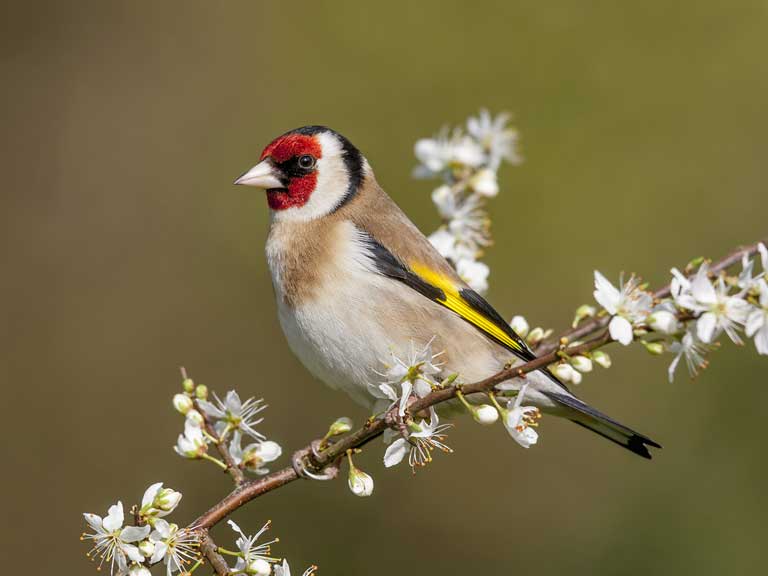
Scientific Name: Carduelis carduelis
Range: Europe and the Middle East
The European goldfinch is a small finch with a pink bill, a bright red face, and bold black and yellow flashes on the wings.
Depending on the location, some goldfinches have a black and white cowl while others do not. They’re found in a wide array of habitats, from wooded areas like forests to open areas like meadows or grasslands.
Because these birds typically feed on thistle seeds, their brown and pink plumage helps them blend perfectly into the plants. Unless you come across an adult with a bright red face or see their black and yellow wings, it’s nearly impossible to locate them in the thistle from just their plumage.
16. Common Eider

Scientific Name: Somateria mollissima
Range: Northern Canada, Greenland, Northern Europe, and Siberia
The common eider is a large sea duck that displays clear sexual dimorphism. The males display contrasting white and black plumage with a hint of green on the nape, while the females’ plumage can vary anywhere from a rich reddish-brown to a dark grayish color. They usually dive into the water in search of mollusks and other crustaceans.
Because females typically lay their eggs and build their nests on coastal grass, their brown to gray coats can prove extremely helpful in protecting them from predators by camouflaging in the surroundings.
Unlike males, who display bright, contrasting black and white coats to attract mates, females use their somewhat dull-colored plumage to protect themselves and their young.
17. American Kestrel
Scientific Name: Falco sparverius
Range: North and South America
The American kestrel is one of the smallest falcons in North and South America, with it having the typical falcon-shaped wings, which are slim and pointed, and a long, square-tipped tail.
This species also displays sexual dimorphism as the males are easily distinguished from the females and juveniles by their plumage, which is grayer at the crown. The American kestrel is typically found perched on a roadside wire or hanging low over a field on rapidly beating wings in search of prey.
Their plumage helps them in two ways: by camouflaging them into their nesting cavities and in the open fields, where they can often remain motionlessly perched in one spot for hours.
18. Eurasian Woodcock
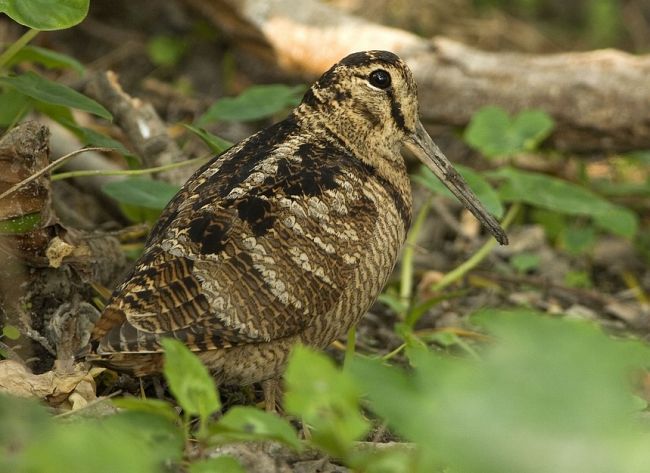
Scientific Name: Scolopax rusticola
Range: Mainly spread throughout Europe, with occasional sightings in Asia
The Eurasian woodcock is a bird with a long bill and big, set-back eyes, which allow it to search the ground for earthworms and small insects, and spot potential predators from afar, respectively.
These birds are common but rarely seen due to them being mainly active at dawn and dusk. They prefer the damp, leafy grounds in forests and woodlands, where they can search through the foliage with their long bills.
Because the light brown plumage of the Eurasian woodcock is not as brightly stripped as the smaller and slimmer snipes, it’s able to blend into its surrounding foliage much more easily. As a result, due to a combination of both its camouflage abilities and its limited active time, the Eurasian woodcock is easily missed even by seasoned birdwatchers.
Conclusion
Birds that have mastered the art of camouflage can be found all around the world (if you’re patient and look carefully enough). They also have very distinct methods of camouflage that are unique to the species for a variety of purposes. To find one, all you’ll have to do is to know where to look and preferably bring a pair of binoculars.
12 Birds That Look Like Orioles






